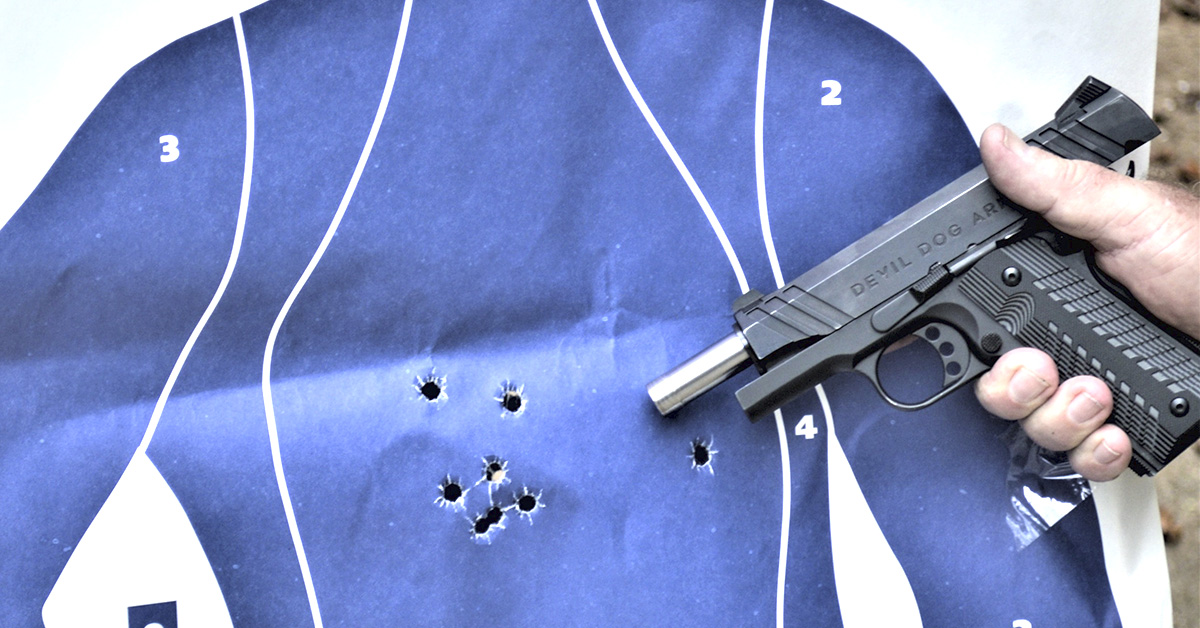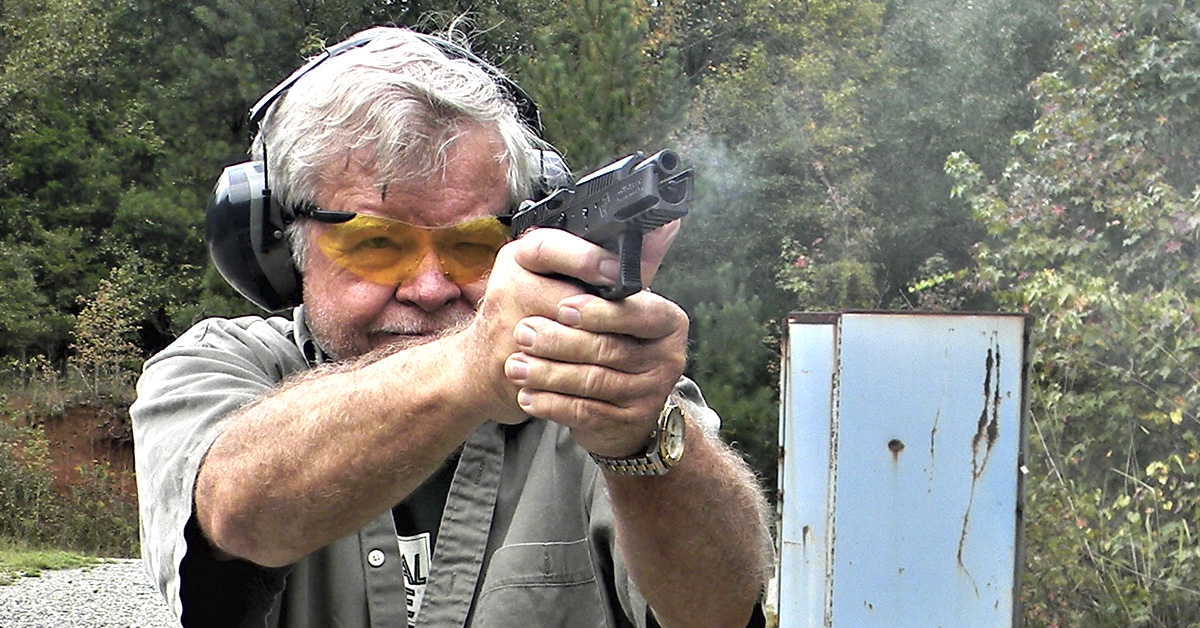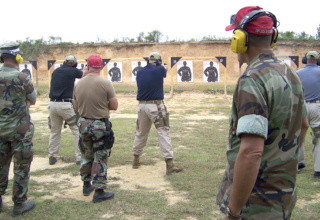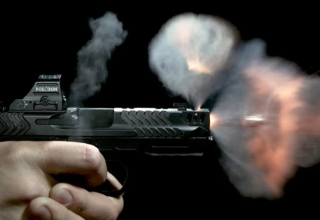The ability to send rounds quickly downrange must always be tempered by accuracy. Here are the important points that help bring it all together.
by Bob Campbell
I am not certain who the first firearms instructor was. I suppose it was a family chore or perhaps someone was tasked with the duty about Cyrano’s time. “Be careful, you have only one shot” was probably a common refrain.
I have heard quite a few truisms I took to heart that are no longer carved in stone. “If you are making really small groups, you are shooting too slow,” is one.
This isn’t always true. Some folks can make small groups and shoot fast at the same time.
“Only hits count,” is a no-brainer.
“Speed is good but accuracy is final.” Whoever first said it (it may have been a young man named David armed with a sling and a stone), it is a great saying.
“You cannot shoot fast enough to catch up,” is another valid remark. But speed and accuracy are a possible combination.
That “distance favors a trained shooter” is true; however, you cannot choose the fight time or the distance. If we could, “feet don’t fail me now” might be the better choice.
I have known fine shots who just could not speed up. Some were hunters who respected their game and took careful, deliberate shots. The transition to personal defense shooting proved tough for them. I have also known students who were just too jumpy and emptied their handguns into the target as quickly as possible, seldom gracing the paper with a perforation where it would do some good.
There is an equilibrium between speed and accuracy, and for those who practice there is real proficiency.
I think some shooters intuitively understand shooting and do very well without extensive instruction. They are self-taught. While an instructor may debate this observation, it is true. A middle-aged lady in the next firing station beside me at the indoor range this week proved that out. With a stainless-steel Walther PPK, she set a bowling pin target at 10 yards and proceeded to ring the neck of the pins every time in what I thought was a good cadence. I cannot help but notice other shooters at the range. Some shoot at an amazing level. Most do not.

I respect modern techniques and do not immerse myself in any but the most up-to-date syllabus. Still, the basics are tenets that do not change. Self-analysis, study, and execution of proper technique are the foundation of proficiency in any art. If I ask ten people the secret to shooting fast, most will say “pull the trigger faster.” I am certain I could train a chimpanzee to empty a gun quickly. I cannot guarantee where the bullets would hit. Trigger control is important, but it isn’t the most important component. The basics of marksmanship combine into skills.
Slow-fire marksmanship is important and learning the grip, sight picture, sight alignment, and trigger press is important. All are important in speed shooting. But target shooting isn’t combat shooting and combat shooting is what I am concerned with. We must be prepared for an emergency. Danger and complacency are fraternal twins.

So, let’s look at the complexity of an accurate response to a threat. A compromise between speed and accuracy is important and life is full of compromises. The balance of speed and retention in the holster is a compromise and the balance between size, weight, and combat ability in a handgun is a compromise. But we like to aggrandize the handgun’s capability. Reliability cannot be compromised, and the shooter’s training should not be compromised.
The presentation from concealed carry is an important lead-in to fast, accurate shooting. Once the handgun is presented, there is no going back. The adversary will kill you unless you stop his attack. Your delay or hesitation in getting on target and getting a hit is a gift to the adversary. He may not be very skilled, but it doesn’t take a lot of skill for him to shove a gun your way and wildly jerk the trigger. Or he may be calm and deliberate and ring your bell. You don’t know the skill set of the adversary any more than you may predict danger — save if something has occurred once, odds are it will occur again, and there is plenty of gunplay every day.

Move the elbow to the rear quickly, bend the arm at the elbow and scoop the pistol out of the holster. Don’t move the hand to the holster, stop, and then draw. You will be behind the curve. Practice moving the covering garment aside to clear the handgun from the holster. Affirm the grip in the holster. Move the gun toward the target. Meet the support hand in front of the chest and go into a two-hand grip — depending on the distance. Affirm the sight picture always. It is possible to miss at ridiculously close range if you do not aim the handgun.
I see an unfortunate reliance on capacity over skill. This leads to less reliance on marksmanship. Some will adopt the higher capacity pistol — even including a 22-round 5.7 pistol — over a harder hitting and good shooting pistol with a reasonable capacity. An ammunition reserve is good, but it isn’t a substitute for marksmanship and power.

The shot being fired at the moment is the most important shot you will fire. Each shot is an individual event, not a string of shots. Speed is simply a product of practicing the presentation, grip, sight alignment, sight picture, and trigger press until it all comes together in a smooth combination.
Jerking the trigger is a spasmatic reaction to stress, muzzle blast, or recoil. Don’t jerk the trigger! Dry fire enough to realize that if you jerk the trigger, you are jerking the sights left or right or even pulling the muzzle down. Press the trigger smoothly and quickly.

I have watched videos of competition shooters who take their finger off the trigger for every shot — and they are very good and very fast. That said, most combat shooters ride the trigger during reset. We often teach that, as the shot breaks, the shooter allows the trigger to reset as he regains the sight picture after recoil. Recoil control is as important as trigger control.
An important point: truly rapid, accurate shooting begins with affirming the grip in the holster and directing the handgun toward the target. Keep the finger off the trigger until you are ready to fire. As you align the sight picture, the finger is on the trigger as you begin the trigger press.
Note that pressing the trigger is a reaction to a clear threat and a response to an armed adversary. If the need for a shot is not clear, the finger should be straight alongside the gun and away from the trigger.

The handgun is aligned on target and trigger slack is taken up. The point of resistance commonly termed “the wall” is met and you keep pressing and break the shot. With practice, the trained shooter will break the shot as the presentation is completed.
The first shot is the most important. Practice getting that first shot after presentation and then practice from the belt up and get good hits. You deal with recoil control with a firm grip. The pistol recoils and the trigger resets as you bring the pistol back on target.
The next step is firing, getting a hit, and then riding the reset as you control recoil. Speed depends on distance. If the target or threat is at 5 to 7 yards, you may be running quickly with follow up shots. You slow down only slightly at 10 to 15 yards. Practice is what matters along with attention to every detail, not merely the trigger press.
Through it all, keep a tight sight picture and sight alignment. I usually incorporate speed loads into the practice regimen. After all, since we reload during practice, we may as well make it a smooth speed load, but I don’t practice speed loads at the expense of accuracy.
My type of training is perhaps more severe than some. I train hard. I don’t do as many knuckle pushups as I once did. I still punch a tape-wrapped board, although not as hard as I once did. I can get my body running hot in speed drills.
The bottom line: learn to see the blade coming for your back and how to react quickly and decisively. And shoot with a skilled partner if possible. Example is the school of mankind.

















